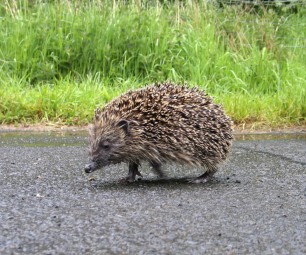Perhaps the biggest hedgehog story for some time, and I am in the thick of it. Today, 1st June, we are launching ‘Hedgehog Street‘. And, as Melvyn Bragg is so keen on saying as he befuddles audiences on In Our Time (one of my favourite radio programmes), now I ought to ‘unpack’ that a little.
The British Hedgehog Preservation Society and the People’s Trust for Endangered Species have been working together for many years, but this is our biggest effort yet. In the past we have developed projects such as HogWatch and we also support the rather unfortunate Mammals on Roads surveys (unfortunate because it relies on the murderous rampage of the motor car to help us monitor fluctuations in the hedgehog population).
What these projects have revealed is alarming. But we wanted to check that the serious decline in hedgehog numbers was ‘real’ and not just a quirk of the way the data were collected. So we employed some of the best ecological statisticians at the British Trust for Ornithology (I know, they do birds, but they also do numbers REALLY well) and they used our figures along with data they had collected. From this we can unequivocally state that in the last ten years, the hedgehog population of Britain has declined by around 25%.
This is alarming. The hedgehog is an excellent indicator of the state of our environment, it is also a wonderfully robust creature that has managed to fit brilliantly into our world. So what has changed? And what can we do about it?
The answer is something I have been banging on about for years. Habitat fragmentation.
At its most obvious, this would be a busy road being built through an area of hedgehog habitat. Hedgehogs would then be unable to get from one side to the other. But fragmentation is far more insidious. It happens in the rural landscape because fields get bigger and hedges remain unmanaged. It is exacerbated by the increase in badgers, the presence of which prevents hedgehogs moving along the remaining hedgerows. And it happens in the last refuge of the hedgehog, suburbia.
In A Prickly Affair, I wrote about the suburban doughnut … the circle of rich hedgehog territory that surrounds the desert its heart. But this doughnut of interconnected gardens is also being fragmented. Obviously, busier roads make a hedgehog’s life harder. But so does infill development, so does the destruction of wildlife friendly gardens with extensions, decking, patios and car-ports. And so do fences with concrete footings. You might have the very best hedgehog friendly garden in the city – and I have had this question asked of me many times – but no hedgehogs. Well, if they cannot get into your garden, they will not appear.
And this is where Hedgehog Street comes in. This innovative project has been set up to help us all recreate a mosaic of interconnected habitats in suburbia. There is an information pack with all the details, the website also has top tips, but what it comes down to is the simple fact that if we open out our gardens to hedgehogs by allowing them to move between them, we massively increase their chances of survival.
The figures are amazing, there are around 433,000 hectares of garden and if we could get just 0.1% of them involved, that would create a hedgehog refuge larger than Sherwood Forest!
So log on to Hedgehog Street, get your pack and get active – and don’t forget to share the fun, post your stories on the forum, get local media interest (this will be on SpringWatch soon) and get out there with a saw and a sledgehammer!
So there is plenty we can do, but there is one fact that this analysis of historic data has thrown up that shook me to my core. The population estimate for hedgehogs in Britain in 1950 was around 30 million. In 1995 it was about 1.5 million. Now, probably nearer one million. That is less than 5% of the 1950 figure. That means we have lost over 95% of our hedgehogs in just 60 years. Please re-read that sentence. It is possible that the original figure is an over-estimate. But, say, it is double what was really out there, that would still mean we have a 90% population decline on our hands.
This leads me to something else that has been bothering me for sometime. It is the idea of ‘shifting baselines’. We are worried about the substantial decline we are aware of – and there is no denying how serious it is – but this is a quite small decline compared to what we have already lost. Shifting baselines kick in when we make assessments about the state of populations based on the knowledge that we personally have. So my idea of a healthy population of hedgehogs will be heavily influenced by my early memories of abundance. That memory acts as a baseline from which I now look in distress at the current population level. But the situation is far worse than that as my baseline is drawn from an already devastated population. And this is true for everything. There is simply far less wildlife out there than there was. And the reason is because we have killed it or we have destroyed the habitat necessary for it to flourish.
This is something to feel sadness and anger about, but it is vital we do not let that beat us into submission. I know many people think my passion for hedgehogs a little eccentric, but the truth is, it is a passion for all wildlife, and the message the hedgehog tells us now is one we must heed. Remember – we might have already lost 95% of the country’s hedgehogs. Grieve, then act; give the hedgehogs a treat.

